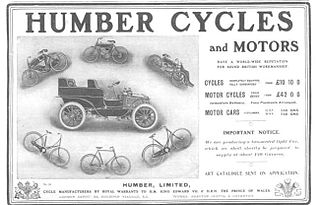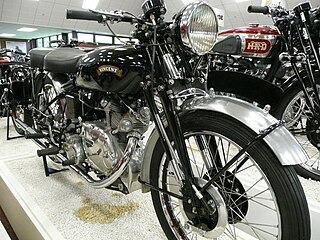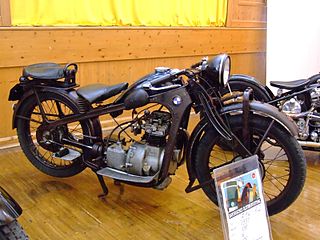
Velocette is a range of motorcycles made by Veloce Ltd, in Hall Green, Birmingham, England. One of several motorcycle manufacturers in Birmingham, Velocette was a small, family-owned firm, selling almost as many hand-built motorcycles during its lifetime as the mass-produced machines of the giant BSA and Norton concerns. Renowned for the quality of its products, the company was "always in the picture" in international motorcycle racing from the mid-1920s until the 1950s, culminating in two World Championship titles and its legendary and still-unbeaten 24 hours at over 100 mph (161 km/h) record. Veloce, while small, was a great technical innovator and many of its patented designs are commonplace on motorcycles today, including the positive-stop foot shift and swinging arm rear suspension with hydraulic dampers. The business suffered a gradual commercial decline during the late 1960s, eventually closing in February 1971.
Coventry Victor was a British motorcycle and car manufacturer. Originally Morton & Weaver, a proprietary engine manufacturer in Hillfields, Coventry, founded in 1904, the company changed its name to Coventry Victor Motors in 1911. The company closed in 1971.
ABC Motors Limited of Hersham, Surrey, England was a manufacturer of cars, aircraft, motor scooters, and engines for road and air. Established by Ronald Charteris in Hersham, Surrey in 1912, its chief designer was the young and talented Granville Bradshaw. It was absorbed into Vickers in 1951 and the factory finally closed in the 1970s. Last occupied by Ian Allan Publishing as Hersham's Riverdene Industrial Estate, the factory was demolished around 2017-2018 and redeveloped as a Lidl supermarket with flats above.

A motorcycle engine is an engine that powers a motorcycle. Motorcycle engines are typically two-stroke or four-stroke internal combustion engines, but other engine types, such as Wankels and electric motors, have been used.

The intake/inlet over exhaust, or "IOE" engine, known in the US as F-head, is a four-stroke internal combustion engine whose valvetrain comprises OHV inlet valves within the cylinder head and exhaust side-valves within the engine block.

The Cotton Motor Company, was a British motorcycle manufacturer of 11a Bristol Road, Gloucester, and was founded by Frank Willoughby Cotton in 1918. F.W. presided over the company until his retirement in 1953. The company was reconstituted as E. Cotton (Motorcycles) Ltd, and traded until 1980. The marque was later resurrected in the late 1990s by a business which manufactured replicas of earlier machines.

Unit construction is the design of larger motorcycles where the engine and gearbox components share a single casing. This sometimes includes the design of automobile engines and was often loosely applied to motorcycles with rather different internal layouts such as the flat twin BMW models.
The Janoir was a French motorcycle manufactured from 1919 until 1922 in Saint-Ouen. The few that were made were 965 cc flat twins.
Rex, Rex Motorcycles, Rex-Acme, was a car and motorcycle company which began in Birmingham, England in 1900. Rex soon merged with a Coventry maker of bicycles and cars named Allard and then later in 1922 the company merged with Coventry's 'Acme' motorcycle company forming 'Rex Acme'. The company existed until 1933, and, in its heyday, was considered one of the greatest names in the British motorcycle industry.
Martinsyde was a British aircraft and motorcycle manufacturer between 1908 and 1922, when it was forced into liquidation by a factory fire.
Blackburne was a trade name of Burney and Blackburne Limited a British manufacturer of motorcycles from 1913 to 1922 at Tongham near Farnham, Surrey. They were also a major supplier of engines to other motor cycle and light car makers and continued to make these until 1937. Burney and Blackburne also made small aircraft engines.

Victoria was a bicycle manufacturer in Nürnberg, Germany that made motorcycles from about 1901 until 1966. It should not be confused with a lesser-known, unrelated Victoria Motorcycle Company in Glasgow, Scotland that made motorcycles between 1902 and 1928.

Humber Limited was a pioneering British motorcycle manufacturer. Humber produced the first practical motorcycle made in Britain by fitting one of their Humber bicycles with an E. J. Pennington two-horsepower motor in 1896.

The Vincent Comet was designed and built at the Vincent works in Great North Road, Stevenage, Hertfordshire, England. It was one of four 499 cc single models. As well as the sports Comet, Vincent produced a TT racing model, the Comet Special and the standard Vincent Meteor which shared many of the same cycle parts.
Granville Eastwood Bradshaw OBE, AFRAeS (1887–1969) was an English engineer and inventor who designed motorcycle, auto, and aero-engines.

Meguro motorcycles were built by Meguro Manufacturing Co motorcycle works (目黒製作所), founded by Nobuji Murata and a high-ranking naval officer, Takaji Suzuki, in 1937. One of the first Japanese motorcycle companies, it became a partner of Kawasaki Heavy Industries Ltd, and was eventually absorbed. Named after a district of Tokyo, Meguro had its roots in Murato Iron Works, which was established in 1924. Meguro Seisakusho, which had once developed a copy of a Harley-Davidson V-twin, was established to design and build gearboxes for the nascent Japanese motorcycle industry. Abe Industries, which had once produced its own motorcycle, merged with Meguro in 1931. The brand is being revived by Kawasaki with a new K3 model to be introduced in Japan on February 1, 2021.

The BMW R2 was a 198 cc overhead valve single-cylinder motorcycle produced by BMW between 1931 and 1936, the smallest motorcycle ever to enter series production with the firm. Despite its much smaller design and engine capacity, the R2 retained many features of the larger boxer twin motorcycles in the range, such as cardan shaft drive and a pressed-steel duplex frame. The R2 was the smallest in the range of singles produced during the 1930s by BMW, with its big brothers being the 305 cc R3 and the 400 cc R4.

The Cleveland Motorcycle Manufacturing Company, sometimes called Cleveland Motorcycle, was a motorcycle manufacturer in Cleveland, Ohio, from 1902 to 1905 and again from 1915 to 1929.

The Triumph 6/1 is a motorcycle that was made by Triumph at their Coventry factory from 1934 to 1936. Designed by Val Page, the 6/1 was the first Triumph motorcycle to use a parallel-twin engine. A sidecar-equipped 6/1 won a silver medal in the 1933 International Six Days Trial and went on to win the Maudes Trophy for 1933. The 6/1 was a commercial failure, selling fewer than 600 in two years on the market.

BSA motorcycles were made by the Birmingham Small Arms Company Limited (BSA), which was a major British industrial combine, a group of businesses manufacturing military and sporting firearms; bicycles; motorcycles; cars; buses and bodies; steel; iron castings; hand, power, and machine tools; coal cleaning and handling plants; sintered metals; and hard chrome process.
















